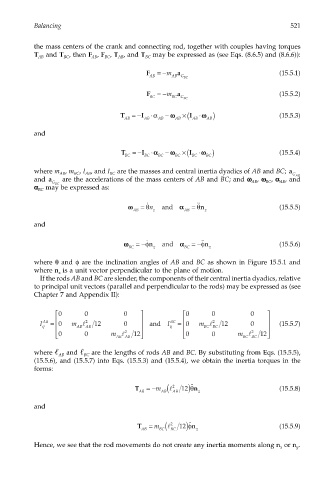Page 540 - Dynamics of Mechanical Systems
P. 540
0593_C15_fm Page 521 Tuesday, May 7, 2002 7:05 AM
Balancing 521
the mass centers of the crank and connecting rod, together with couples having torques
T and T , then F , F , T , and T may be expressed as (see Eqs. (8.6.5) and (8.6.6)):
AB
BC
AB
AB
BC
BC
F =− m a (15.5.1)
AB AB G BC
F =− m a (15.5.2)
BC BC G BC
T =− I ⋅α − ωω × I ( ⋅ωω AB) (15.5.3)
AB AB AB AB AB
and
T =− I ⋅αα − ωω × I ( ⋅ωω BC) (15.5.4)
BC BC BC BC BC
where m , m , I , and I are the masses and central inertia dyadics of AB and BC; a G AB
BC
AB
AB
BC
and a are the accelerations of the mass centers of AB and BC; and ωω ωω , ωω ωω , αα αα , and
AB
BC
AB
G BC
αα α α may be expressed as:
BC
˙˙
ωω = θ ˙ n and αα = θn (15.5.5)
AB z AB z
and
˙
ωω =−φn and αα =−φn (15.5.6)
˙˙
BC z BC z
where θ and φ are the inclination angles of AB and BC as shown in Figure 15.5.1 and
where n is a unit vector perpendicular to the plane of motion.
z
If the rods AB and BC are slender, the components of their central inertia dyadics, relative
to principal unit vectors (parallel and perpendicular to the rods) may be expressed as (see
Chapter 7 and Appendix II):
0 0 0 0 0 0
I AB = 0 m l 2 12 0 and I BC = 0 m l 2 12 0 (15.5.7)
ij AB AB ij BC BC
0 0 m l 2 12 0 0 m l 2 12
BC BC
AB AB
where and are the lengths of rods AB and BC. By substituting from Eqs. (15.5.5),
BC
AB
(15.5.6), and (15.5.7) into Eqs. (15.5.3) and (15.5.4), we obtain the inertia torques in the
forms:
T =− m (l 2 12 ˙˙ n )θ (15.5.8)
AB AB AB z
and
T = m (l 2 12 ˙˙ n )φ (15.5.9)
AB BC BC z
Hence, we see that the rod movements do not create any inertia moments along n or n .
y
x

